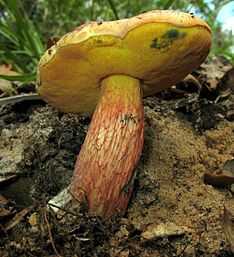Suillellus floridanus
| Suillellus floridanus | |
|---|---|
 | |
| Scientific classification | |
| Kingdom: | Fungi |
| Division: | Basidiomycota |
| Class: | Agaricomycetes |
| Order: | Boletales |
| Family: | Boletaceae |
| Genus: | Suillellus |
| Species: | S. floridanus |
| Binomial name | |
| Suillellus floridanus (Singer) Murrill (1948) | |
| Synonyms[1] | |
| |
| Suillellus floridanus | |
|---|---|
|
| |
| pores on hymenium | |
|
cap is convex or flat | |
| hymenium is adnate | |
| stipe is bare | |
| spore print is olive-brown | |
| ecology is mycorrhizal | |
| edibility: edible | |
Suillellus floridanus (formerly Boletus floridanus) is a species of bolete mushroom in the Boletaceae family. In 1945, American mycologist Rolf Singer described a species he found in Florida during his 1942–3 tenure of a Guggenheim Memorial Fellowship.[2] He originally described it as a subspecies of the eastern North American species Boletus frostii, but later considered it worthy of distinct species status in a 1947 publication.[3] Although known as a species of Boletus for over 50 years, the current interpretation, based on molecular phylogenetic analysis,[4] is that the taxon belongs in Suillellus.[5]
Suillellus floridanus differs from the Boletus frostii in having a lighter cap color[6] and in texture of the cap surface: the subspecies is tomentose (covered with dense, short, soft, matted hairs) or velutinous (like velvet), compared to the relatively smooth surface of B. frostii. Singer notes that although the physical characteristics between the two taxa may be blurred and are hard to define, the area of origin is a reliable indicator of subspecies status. S. floridanus is found on shaded lawns and scrubland in open oak stands in non-tropical regions of Florida, typically on grassy or sandy soil. It grows under or near several oak species, including chapman oak (Quercus chapmanii), swamp laurel oak (Q. laurifolia), and southern live oak (Q. virginiana), and it fruits between May and October.[3]
See also
References
- ↑ "Synonymy: Suillellus floridanus (Singer) Murrill". Species Fungorum. CAB International. Retrieved 2014-11-24.
- ↑ Singer R. (1945). "New Boletaceae from Florida (a preliminary communication)". Mycologia 37 (6): 797–9. doi:10.2307/3755143. JSTOR 3755143.
- ↑ 3.0 3.1 Singer R. (1947). "The Boletoideae of Florida with notes on extralimital species III". American Midland Naturalist 37 (1): 77–8. JSTOR 2421647.
- ↑ Nuhn ME, Binder M, Taylor AFS, Halling RE, Hibbett DS. (2013). "Phylogenetic overview of the Boletineae". Fungal Biology 117 (7–8): 479–511. doi:10.1016/j.funbio.2013.04.008. PMID 23931115.
- ↑ Vizzini A. (2014). "Nomenclatural novelties" (PDF) (188). Index Fungorum. p. 1. ISSN 2049-2375.
- ↑ Specifically, "Corinthian red" in the subspecies compared with "jasper red", "nopal red" or "carmine" in the typical form, using Ridgway color standards.